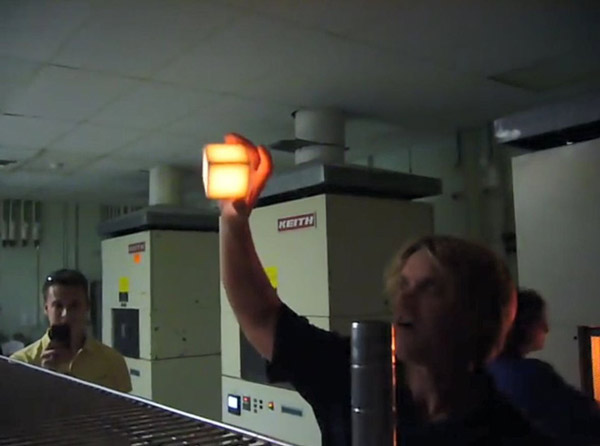Holding a 1,200 degree Celsius brick with your bare hands and an interesting secret behind it
From 1981 to 2011, a reusable, space shuttle manned by the US Aeronautics and Space Administration (NASA) traveled many times between Earth and outer space. The ship can withstand friction and high temperatures can reach over 1,600 degrees Celsius when it hits a thick atmosphere when returning to Earth.
But the main body of the shuttle is finished in a lightweight aluminum that can be softened to about 200 degrees Celsius. Therefore, scientists have researched an insulating brick called LI-900. , a heat-resistant material that protects the main body from extreme temperatures.
 Holding a 1,200 degree Celsius brick with your bare hands and an interesting secret behind it Picture 1 Demonstration of super-insulated bricks, LI-900.
Holding a 1,200 degree Celsius brick with your bare hands and an interesting secret behind it Picture 1 Demonstration of super-insulated bricks, LI-900. The LI-900 is made of silica fiberglass of up to 99.9% purity, but 94% of its volume is air and has excellent thermal insulation properties. It has extremely high performance and thermal insulation even when heated at temperatures of 1200 degrees and above.
The ultra-poor thermal conductivity of the LI-900 allows humans to be touched with bare hands, as soon as they are taken from the furnace after hours. Therefore, when these heat-resistant bricks are applied to the shuttle hull, they can protect the aluminum below from the heat when re-entering the atmosphere.
In the video, you can see the brick looks like sponges. It is heated in an oven to temperatures up to 1,200 degrees Celsius for hours, the equivalent of the heat of re-entering the atmosphere. When removed from the oven, it is extremely hot, to the point of glowing orange and looking very hot. However, the man in the video could immediately use his bare hands, without gloves, to help touch the LI-900.
Unlike conventional materials, LI-900 does not radiate heat by special structure. However, it also emits a certain amount of heat, so the man in the video only touches and lifts it up by touching the corners of the brick.
You should read it
- Nanowood white materials promise special insulation
- Lego is about to unveil a kind of bricks made of vegetable plastic
- What is a super app?
- How to remove red bricks for messages on Skype Windows 10
- What is AMD's FSR? What does the FSR do?
- Falcon Heavy - The world's most powerful super rocket can reach thrust of more than 2,300 tons
- Compare Nvidia RTX 4070 Super, RTX 4070 Super Ti and RTX 4080 Super
- New coating helps supersonic aircraft withstand temperatures up to 3000 degrees Celsius
- How to download and play Super Mario Run game on Android
- Appear Nokia phone 'brick' running Android 8.1
- Don't miss the biggest super moon view in 2017 in the afternoon and tonight, Vietnam can see it
- Hire an architect to re-decorate the toilet but do not remove the bricks and the results are unexpected!
May be interested

Coronavirus lockdowns: Can you go outside, to the gym, on a drive and other answers

Why homemade face masks may not protect you from coronavirus

What is nano curcumin? What is curcumin in turmeric?

We may be able to see the 'second moon' in the sky with the naked eye next May

What a glow-up: Next-gen NASA moon lander thruster looks radiant during hot-fire test

Hospital uses VR to show how the coronavirus impacts the lungs






 How to hold hands with that person reveals exactly the relationship of the two
How to hold hands with that person reveals exactly the relationship of the two 4 ways to insert the Celsius symbol in Excel on all versions
4 ways to insert the Celsius symbol in Excel on all versions 4 ways to hold hands revealing your personality
4 ways to hold hands revealing your personality How to convert F degrees to Celsius on iPhone
How to convert F degrees to Celsius on iPhone FITT360 helps you take photos, record 360-degree videos without holding the camera
FITT360 helps you take photos, record 360-degree videos without holding the camera What miracle will come to the body when holding hands in these ways?
What miracle will come to the body when holding hands in these ways?